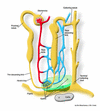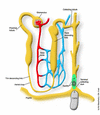Nephrolithiasis: site of the initial solid phase
- PMID: 12618514
- PMCID: PMC151909
- DOI: 10.1172/JCI18016
Nephrolithiasis: site of the initial solid phase
Figures


Comment on
-
Randall's plaque of patients with nephrolithiasis begins in basement membranes of thin loops of Henle.J Clin Invest. 2003 Mar;111(5):607-16. doi: 10.1172/JCI17038. J Clin Invest. 2003. PMID: 12618515 Free PMC article.
References
-
- Monk, R.D., and Bushinsky, D.A. 2003. Kidney stones. In Williams textbook of endocrinology. P.R. Larsen, H.M. Kronenberg, S. Melmed, and K.S. Polonsky, editors. W.B.Saunders. Philadelphia, Pennsylvania, USA. 1411–1425.
-
- Randall A. Papillary pathology as a precursor of primary renal calculus. J. Urol. 1940;44:580–589.
-
- Finlayson B, Reid F. The expectation of free and fixed particles in urinary stone disease. Invest. Urol. 1978;15:442–448. - PubMed
-
- Lieske JC, Toback FG. Renal cell-urinary crystal interactions. Curr. Opin. Nephrol. Hypertens. 2000;9:349–355. - PubMed

